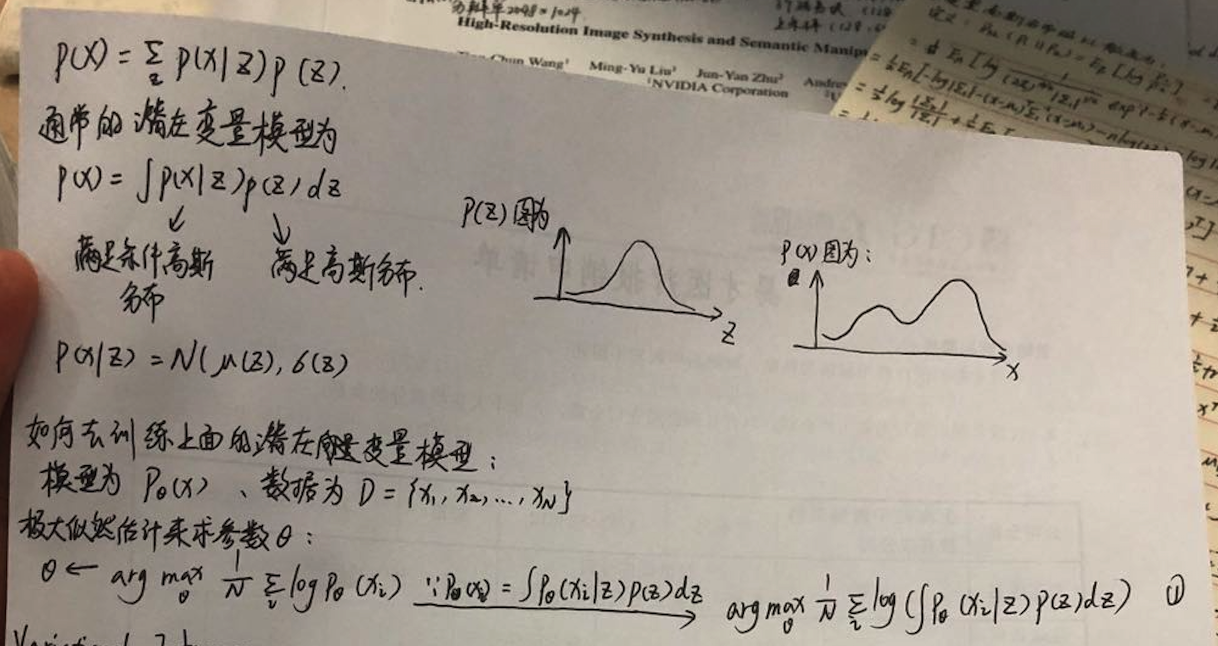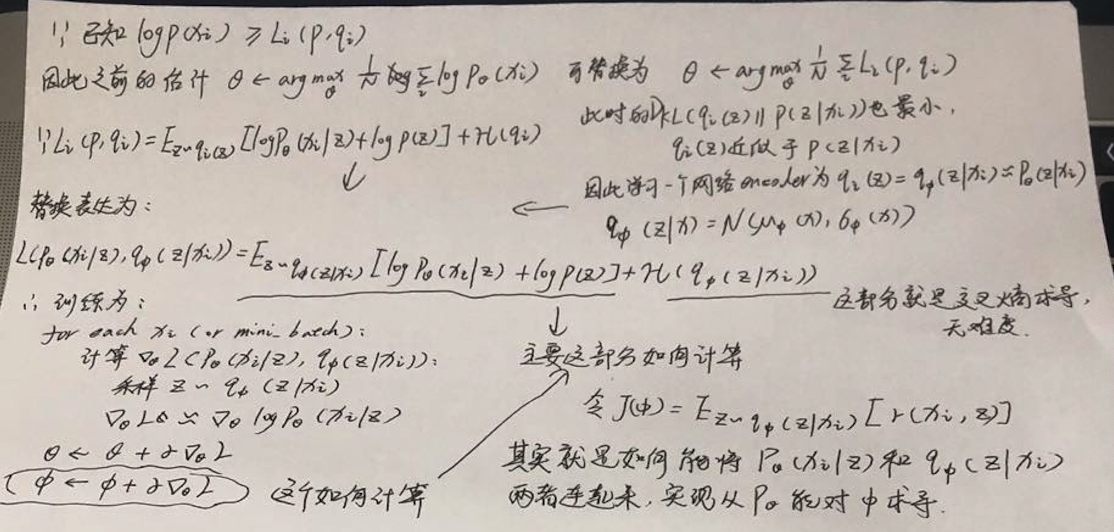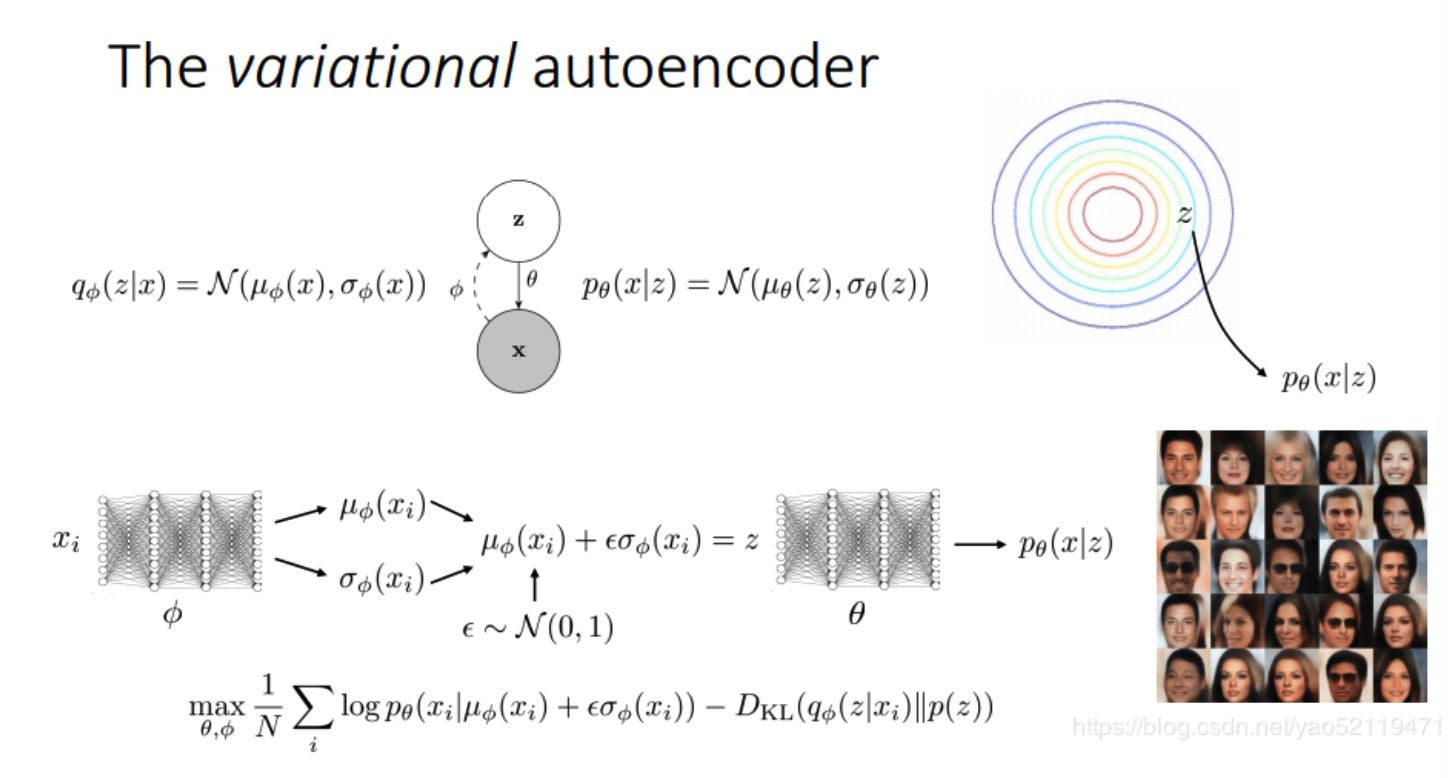VAE论文学习
intractable棘手的,难处理的 posterior distributions后验分布 directed probabilistic有向概率
approximate inference近似推理 multivariate Gaussian多元高斯 diagonal对角 maximum likelihood极大似然
参考:https://blog.csdn.net/yao52119471/article/details/84893634
VAE论文所在讲的问题是:
我们现在就是想要训练一个模型P(x),并求出其参数Θ:

通过极大似然估计求其参数
Variational Inference
在论文中P(x)模型会被拆分成两部分,一部分由数据x生成潜在向量z,即pθ(z|X);一部分从z重新在重构数据x,即pθ(X|z)
实现过程则是希望能够使用一个qΦ(z|X)模型去近似pθ(z|X),然后作为模型的Encoder;后半部分pθ(X|z)则作为Decoder,Φ/θ表示参数,实现一种同时学习识别模型参数φ和参数θ的生成模型的方法,推导过程为:


现在问题就在于怎么进行求导,因为现在模型已经不是一个完整的P(x) = pθ(z|X) + pθ(X|z),现在变成了P(x) = qΦ(z|X) + pθ(X|z),那么如果对Φ求导就会变成一个问题,因此论文中就提出了一个reparameterization trick方法:

取样于一个标准正态分布来采样z,以此将qΦ(z|X) 和pθ(X|z)两个子模型通过z连接在了一起
最终的目标函数为:

因此目标函数 = 输入和输出x求MSELoss - KL(qΦ(z|X) || pθ(z))
在论文上对式子最后的KL散度 -KL(qΦ(z|X) || pθ(z))的计算有简化为:

多维KL散度的推导可见:KL散度
假设pθ(z)服从标准正态分布,采样ε服从标准正态分布满足该假设

简单代码实现:
import torch
from torch.autograd import Variable
import numpy as np
import torch.nn.functional as F
import torchvision
from torchvision import transforms
import torch.optim as optim
from torch import nn
import matplotlib.pyplot as plt class Encoder(torch.nn.Module):
def __init__(self, D_in, H, D_out):
super(Encoder, self).__init__()
self.linear1 = torch.nn.Linear(D_in, H)
self.linear2 = torch.nn.Linear(H, D_out) def forward(self, x):
x = F.relu(self.linear1(x))
return F.relu(self.linear2(x)) class Decoder(torch.nn.Module):
def __init__(self, D_in, H, D_out):
super(Decoder, self).__init__()
self.linear1 = torch.nn.Linear(D_in, H)
self.linear2 = torch.nn.Linear(H, D_out) def forward(self, x):
x = F.relu(self.linear1(x))
return F.relu(self.linear2(x)) class VAE(torch.nn.Module):
latent_dim = def __init__(self, encoder, decoder):
super(VAE, self).__init__()
self.encoder = encoder
self.decoder = decoder
self._enc_mu = torch.nn.Linear(, )
self._enc_log_sigma = torch.nn.Linear(, ) def _sample_latent(self, h_enc):
"""
Return the latent normal sample z ~ N(mu, sigma^)
"""
mu = self._enc_mu(h_enc)
log_sigma = self._enc_log_sigma(h_enc) #得到的值是loge(sigma)
sigma = torch.exp(log_sigma) # = e^loge(sigma) = sigma
#从均匀分布中取样
std_z = torch.from_numpy(np.random.normal(, , size=sigma.size())).float() self.z_mean = mu
self.z_sigma = sigma return mu + sigma * Variable(std_z, requires_grad=False) # Reparameterization trick def forward(self, state):
h_enc = self.encoder(state)
z = self._sample_latent(h_enc)
return self.decoder(z) # 计算KL散度的公式
def latent_loss(z_mean, z_stddev):
mean_sq = z_mean * z_mean
stddev_sq = z_stddev * z_stddev
return 0.5 * torch.mean(mean_sq + stddev_sq - torch.log(stddev_sq) - ) if __name__ == '__main__': input_dim = *
batch_size = transform = transforms.Compose(
[transforms.ToTensor()])
mnist = torchvision.datasets.MNIST('./', download=True, transform=transform) dataloader = torch.utils.data.DataLoader(mnist, batch_size=batch_size,
shuffle=True, num_workers=) print('Number of samples: ', len(mnist)) encoder = Encoder(input_dim, , )
decoder = Decoder(, , input_dim)
vae = VAE(encoder, decoder) criterion = nn.MSELoss() optimizer = optim.Adam(vae.parameters(), lr=0.0001)
l = None
for epoch in range():
for i, data in enumerate(dataloader, ):
inputs, classes = data
inputs, classes = Variable(inputs.resize_(batch_size, input_dim)), Variable(classes)
optimizer.zero_grad()
dec = vae(inputs)
ll = latent_loss(vae.z_mean, vae.z_sigma)
loss = criterion(dec, inputs) + ll
loss.backward()
optimizer.step()
l = loss.data[]
print(epoch, l) plt.imshow(vae(inputs).data[].numpy().reshape(, ), cmap='gray')
plt.show(block=True)
VAE论文学习的更多相关文章
- Faster RCNN论文学习
Faster R-CNN在Fast R-CNN的基础上的改进就是不再使用选择性搜索方法来提取框,效率慢,而是使用RPN网络来取代选择性搜索方法,不仅提高了速度,精确度也更高了 Faster R-CNN ...
- 《Explaining and harnessing adversarial examples》 论文学习报告
<Explaining and harnessing adversarial examples> 论文学习报告 组员:裴建新 赖妍菱 周子玉 2020-03-27 1 背景 Sz ...
- 论文学习笔记 - 高光谱 和 LiDAR 融合分类合集
A³CLNN: Spatial, Spectral and Multiscale Attention ConvLSTM Neural Network for Multisource Remote Se ...
- Apache Calcite 论文学习笔记
特别声明:本文来源于掘金,"预留"发表的[Apache Calcite 论文学习笔记](https://juejin.im/post/5d2ed6a96fb9a07eea32a6f ...
- FactorVAE论文学习-1
Disentangling by Factorising 我们定义和解决了从变量的独立因素生成的数据的解耦表征的无监督学习问题.我们提出了FactorVAE方法,通过鼓励表征的分布因素化且在维度上独立 ...
- GoogleNet:inceptionV3论文学习
Rethinking the Inception Architecture for Computer Vision 论文地址:https://arxiv.org/abs/1512.00567 Abst ...
- IEEE Trans 2008 Gradient Pursuits论文学习
之前所学习的论文中求解稀疏解的时候一般采用的都是最小二乘方法进行计算,为了降低计算复杂度和减少内存,这篇论文梯度追踪,属于贪婪算法中一种.主要为三种:梯度(gradient).共轭梯度(conjuga ...
- Raft论文学习笔记
先附上论文链接 https://pdos.csail.mit.edu/6.824/papers/raft-extended.pdf 最近在自学MIT的6.824分布式课程,找到两个比较好的githu ...
- 论文学习-系统评估卷积神经网络各项超参数设计的影响-Systematic evaluation of CNN advances on the ImageNet
博客:blog.shinelee.me | 博客园 | CSDN 写在前面 论文状态:Published in CVIU Volume 161 Issue C, August 2017 论文地址:ht ...
随机推荐
- Ajax -02 -JQuery+Servlet -实现页面点击刷出表格数据
demo功能分析 jquery 的js文件需要导入,json的三个文件需要导入,不然writeValueAsString 会转化成JsonArray(json 数组)失败 $("#mytbo ...
- python_并发编程——管道
1.管道 from multiprocessing import Pipe conn1,conn2 = Pipe() #返回两个值 conn1.send('wdc') #发送 print(conn2. ...
- 「NOI2012」骑行川藏
「NOI2012」骑行川藏 题目描述 蛋蛋非常热衷于挑战自我,今年暑假他准备沿川藏线骑着自行车从成都前往拉萨. 川藏线的沿途有着非常美丽的风景,但在这一路上也有着很多的艰难险阻,路况变化多端,而蛋蛋的 ...
- mini_frame(web框架)
文件目录: dynamic中:框架 static:css,jss静态文件 teplates:模板 web_server.conf: 配置文件 web_server.py: 主程序 run.sh:运行脚 ...
- 015_Python3 迭代器与生成器
迭代器 迭代是Python最强大的功能之一,是访问集合元素的一种方式. 迭代器是一个可以记住遍历的位置的对象. 迭代器对象从集合的第一个元素开始访问,直到所有的元素被访问完结束.迭代器只能往前不会后退 ...
- DVWA-文件包含漏洞
本周学习内容: 1.学习web安全深度剖析: 2.学习安全视频: 3.学习乌云漏洞: 4.学习W3School中PHP: 实验内容: 进行DVWA文件包含实验 实验步骤: Low 1.打开DVWA,进 ...
- 多路选择器,加法器原理及verilog实现
1.数据选择器是指经过选择,把多个通道的数据传到唯一的公共数据通道上.实现数据选择功能的逻辑电路称为数据选择器,它的作用相当于多个输入的单刀多掷开关.本例程以四选一数据选择器(电平触发)为例. 四选一 ...
- 32、reduceByKey和groupByKey对比
一.groupByKey 1.图解 val counts = pairs.groupByKey().map(wordCounts => (wordCounts._1, wordCounts._2 ...
- ArcGIS Enterprise 10.7.1新特性:批量发布服务
ArcGIS Enterprise 10.7.1提供了批量发布GIS服务的功能,能大大简化GIS系统管理员的工作量. 作为发布人员和管理人员,支持向Portal for ArcGIS添加云存储.文件共 ...
- MySQL5.7 基础之二
设计范式: 第一范式:字段是原子性 第二范式:存在可用主键 第三范式:任何表都不应该有依赖于其它表非主键的字段 创建数据库.设计数据表 字段:字段名.数据类型.约束(通过键来实现,而键其实可以当做索引 ...
